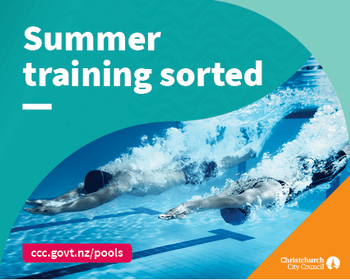An ocean swim that finishes in the surf can provide you with a great opportunity to get ahead of your competitors and save some energy if you know the best ways to use it to your advantage. The tips below will help you learn that surf can be your friend when it comes to getting an easier ride to the shore.
Once around the last buoy, your sight immediately should focus on your shore marker and where possible you should always head for where’s there’s white water, which indicates a clean break. You should be looking behind you every so often (under your arm) checking for approaching waves. There’s nothing worse than the “one that got away” wave.
Below are a few pointers that will help you to body surf your way towards the finish line.
For ease of description, waves come in three types; Rolling, dumping and broken. They can be caught either (a) as they are about to break, or (b) once they have broken, however catching a broken wave is difficult.
The size and shape of the wave will determine how you catch it. The bigger the wave, the less chance you’ll have of holding it. Likewise, the same applies to dumping waves (where the wave height is greater than the depth of water below it, and indicated by the sand being churned up).
Practice will make you almost perfect.
For rolling waves it’s best to try to become part of the wave (i.e. let it take you with it).
You should try to let the wave surround you (relax). For dumpers, get as far ahead of the wave as possible. Before climbing on any wave, take a deep breath.
Rolling waves
Up to about five feet, most rolling waves will be rideable. The basic rule to follow is to keep your head down as often as possible. You should be flat with your hands out in front of you, creating increased surface area and better flotation. Your thumbs should be crossed to lock your hands together.
This serves two purposes:
- It keeps your body out of the water if you press down (good for catching your breath) and
- The hands in this position streamline the body, eliminating drag.
If hands are placed at the sides, drag increases and you will be prone to fall off the wave).
Once the wave is broken and you are down the face, your head should be down and you should only turn it when you need a breath. If the head is lifted it causes the body position to bend, creating drag on the chest, slowing the body and causing the wave to pass you.
At a certain stage the wave will decrease to a size where it becomes necessary for a swimmer to kick and plane to stay on. The planing action is usually one-handed swimming, with the head turned infrequently to the side. (A normal swim stroke does not work, as the body movement on small waves only slows the swimmer to a speed less than the wave).
At all times the body should remain straight, but not tense. You must remain part of the wave and “think light”. Good swimmers, providing they’re not more than 80kg, can ride ripples to shore.
Dumping waves
The method for catching dumpers is the same as for rolling waves, except for the initial phase – the dump. As with even some large, rolling waves, catching the dumper is really a lottery. Some you win, some you don’t.
The secret with dumpers is to get yourself as far in front of the wave as possible as it breaks. This of course means you sometimes have to swim harder for the wave and kick ferociously once aboard (an extra deep breath goes down extra well here).
One technique in the initial stage is to place the hands in front, in line with your shoulders. As you hit the trough, your hands should be used to push your body above the water line.
Broken waves
While not fearsome to catch, broken waves are the most difficult to collect, especially when you can’t stand up.
If you see a broken wave approaching, it’s sometimes best to stop and catch your breath, because you’re going to need it for a sprint to get on board. It’s no good to keep swimming, because that broken wave almost certainly will have some other swimmers from behind you on it, and they’ll pass you if you don’t try to catch the wave.
In theory you should be swimming as fast as, or faster, than the broken wave you want to catch. In reality it’s very difficult, but with a little luck and with the skills you’ve practised, you can narrow the odds to 50-50.
As with all waves you can’t afford to be tense, because you won’t be allowing the wave to “become part of you”. But at the same time, you’ll have to be sprinting. Timing is of the essence, because in a few seconds you have to judge the speed and force of the approaching white water and start swimming at the moment that will allow the wave to reach you as you are at your optimum level for catching it.
Sounds complicated, and it is.
As with all waves, it takes practice.
Once you have caught your chosen wave in towards the shore you can finish off with a few dolphin dives if required and then you are ready to make the dash up the sand towards the finish line.













